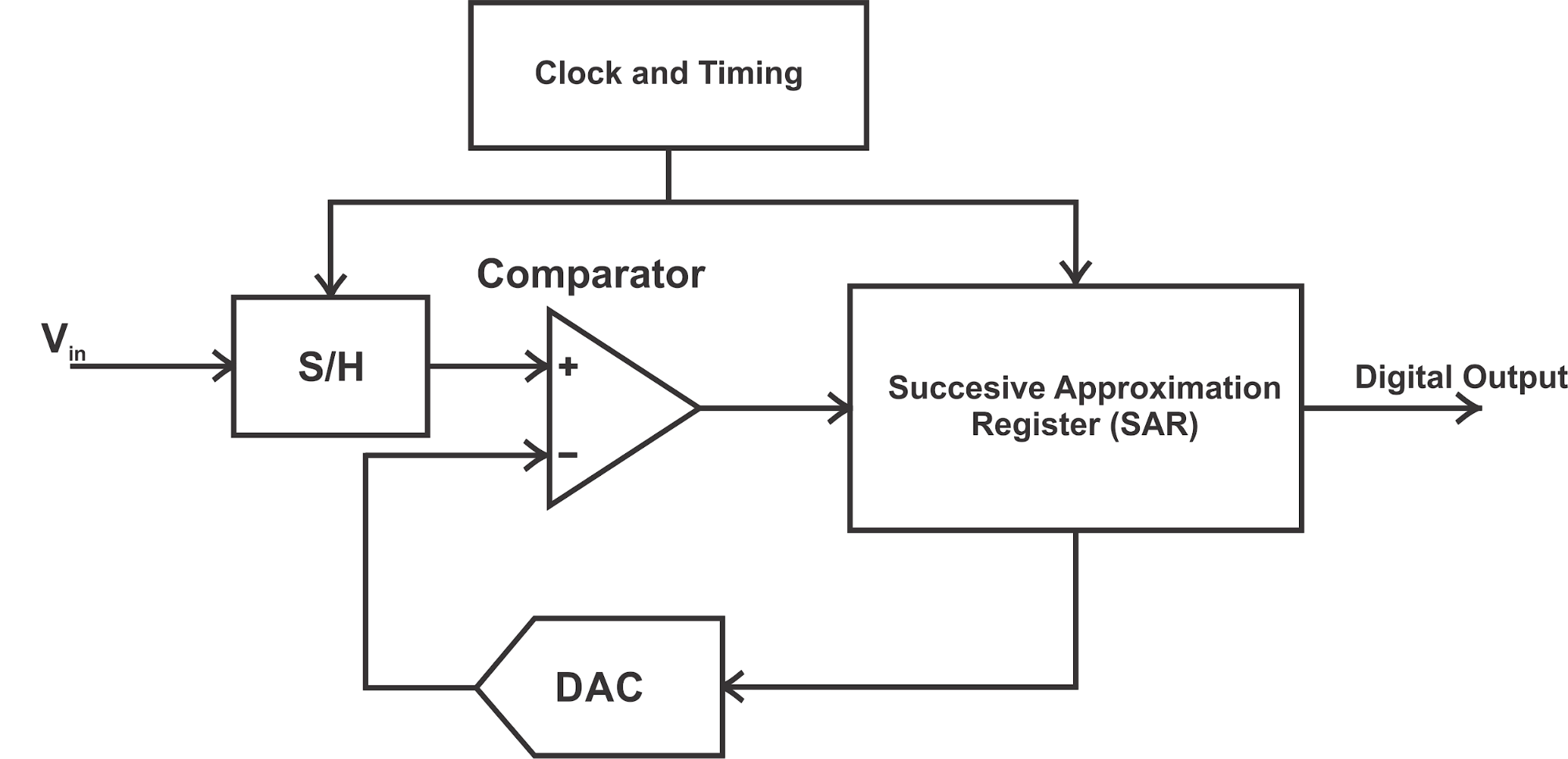An Analog-to-Digital Converter (ADC) is an electronic device or circuit that converts continuous or analog signals into discrete or digital representations. It’s a crucial component in electronics and signal processing, enabling the translation of real-world phenomena into a digital format that can be processed, stored, and analyzed by digital systems like computers.
Introduction

Understanding Analog and Digital Signals
In the field of electronics, signals exist in two primary forms: analog and digital. Analog signals are continuous waveforms that vary smoothly over time and can take on an infinite number of values within a specified range. On the other hand, digital signals are discrete, taking on specific and distinct values within a set range. ADCs facilitate the transition from the continuous, analog world to the digital, discrete world by converting analog signals into digital data, making them compatible with digital processing and storage systems.
The Need for Analog-to-Digital Conversion
In today’s technologically advanced landscape, digital systems, such as computers and microcontrollers, dominate the way we process and communicate information. However, the real-world data we often need to work with is inherently analog. ADCs bridge this divide by enabling the conversion of diverse analog data, including temperature, sound, light, voltage, and more, into a digital format that can be analyzed, manipulated, and utilized by digital systems.
Basics of Analog and Digital Signals
| Aspect | Description |
|---|---|
| Definition | Analog signals are continuous and represent information with a smooth, continuous waveform. They can take on an infinite number of values within a specific range. |
| Representation | Analog signals are represented by a continuous curve where the amplitude at any point corresponds to the value of the signal at that specific time. |
| Nature | Analog signals mimic the behavior of the original physical phenomena they represent. They are natural and can have any value within a given range. |
Digital Signals:
| Aspect | Description |
|---|---|
| Definition | Digital signals are discrete and represent information using a series of distinct values or states. Each state corresponds to a binary value (0 or 1). |
| Representation | Digital signals are represented using binary digits (bits), where each bit is a binary value (0 or 1). |
| Nature | Digital signals are a more accurate representation of information as they are less susceptible to noise and degradation compared to analog signals. They are a simplified version of analog signals. |
Principles of Analog-to-Digital Conversion
- Sampling: Sampling is the first step in ADC and involves capturing the amplitude of the continuous analog signal at specific, evenly-spaced intervals known as sampling intervals or periods. The continuous signal is ‘sampled’ at discrete time points to create a digital representation.
- Quantization: Quantization is the process of assigning a digital value to each sampled amplitude. These digital values are usually in binary form and are representative of the amplitude’s magnitude. The number of bits used for quantization determines the resolution of the ADC.
- Quantization Levels: The number of unique digital values that can be assigned to each sampled amplitude is determined by the number of bits used in quantization. The number of quantization levels is calculated as 2 raised to the power of the number of bits (2^n), where n is the number of bits.
Types of ADCs
| Type | Characteristics |
|---|---|
| Flash ADC | – Fastest type of ADC. – Requires 2^n – 1 comparators for n-bit resolution. – High-speed applications but limited to lower bit resolutions. |
| Successive Approximation ADC | – Utilizes a binary search algorithm for conversion. – Begins with the most significant bit (MSB) and narrows down to the least significant bit (LSB). |
| Delta-Sigma (ΔΣ) ADC | – High resolution and accuracy. – Converts analog signals into a stream of bits at a high oversampling rate. – Utilizes oversampling, noise shaping, and digital filtering. |
| Pipelined ADC | – Splits the conversion process into several stages. – Achieves a good balance between speed and resolution. – Suitable for high-speed applications. |
| Dual Slope Integrating ADC | – Measures the unknown voltage by comparing it with a known reference voltage. – Good for applications requiring high noise immunity and accuracy. |
ADC Specifications
- Resolution:
- Resolution represents the number of bits in the digital output of the ADC.
- Common resolutions include 8, 10, 12, 16, or 24 bits.
- Higher resolution means finer quantization and more accurate representation of the analog signal.
2. Sampling Rate:
- Sampling rate, typically measured in samples per second (SPS), refers to the number of analog samples the ADC can process in one second.
- It defines how often the ADC takes a sample of the analog input to convert it to digital.
3. Accuracy:
- Accuracy measures how close the ADC’s digital output is to the true analog input value.
- It is often expressed as a percentage of the full-scale range (FSR).
Accuracy includes parameters like integral non-linearity (INL), differential non-linearity (DNL), and offset error.
ADC Architecture and Circuits

| Architecture | Circuit | Key Characteristics |
|---|---|---|
| Flash ADC | Uses comparators for parallel comparison. | – Very fast conversion- Requires 2^n – 1 comparators (for n bits)- Not practical for higher resolutions due to the number of comparators. |
| Successive Approximation ADC | Utilizes a binary search algorithm. | – Efficient and widely used- Good balance between speed and resolution- Slower than flash but faster than SAR ADCs. |
| Delta-Sigma (ΔΣ) ADC | Combines delta modulation and digital filtering. | – High resolution and excellent noise rejection- Slower conversion compared to others- Ideal for applications where accuracy is paramount. |
| Pipelined ADC | Divides conversion into stages, each contributing bits to the output. | – Good balance between speed and resolution- Suitable for high-speed applications- More complex architecture. |
Conclusion
Analog-to-Digital Converters (ADCs) play a pivotal role in modern electronics, facilitating the seamless transition from the analog world to the digital domain. The significance of ADCs lies in their ability to convert continuous analog signals into discrete digital representations, enabling precise processing, storage, and analysis of real-world phenomena. Throughout this discussion, we have explored various aspects of ADCs, from their fundamental principles to different architectures and key specifications.
FAQs
An ADC, or Analog-to-Digital Converter, is an electronic device that transforms continuous analog signals into discrete digital values, making it easier to process and analyze the data using digital systems.
ADCs are crucial as they enable electronic devices to interface with the analog world. They are necessary for converting real-world analog signals, such as temperature or sound, into a digital format that can be processed by computers and other digital systems.
Common types of ADCs include Flash ADC, Successive Approximation ADC, Delta-Sigma (ΔΣ) ADC, Pipelined ADC, Dual Slope Integrating ADC, Ramp ADC, Wilkinson ADC, and Time-Interleaved ADC. Each type has unique characteristics and applications.
A Flash ADC compares the input voltage with a set of reference voltages using comparators. The comparators operate in parallel, determining the digital output based on which comparators trigger, providing a very fast conversion.



















